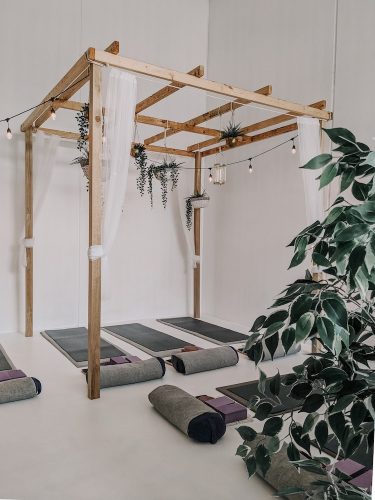Over many years of personal yoga practice, as well as teaching yoga to others, I have come to appreciate the beauty and utility of using props to find Sthira Sukha Asanam, “steadiness and ease,” in the practice. When I began yoga classes in my 20s, I was quick to dismiss props as cumbersome and an interference to doing the “full pose.” I am grateful that I had wise teachers that encouraged using props in a variety of ways that led to not only an acceptance of them but also a love of all they have to offer. Here are a few of the advantages of using props that I appreciate the most:
- Props provide stability. Walls, blocks, chairs, cushions, blankets, etc. can support us to feel firmly established in a pose. Feeling physically stable can also lead to a steady breath and quieter mind. This sense of ease allows one to more fully explore the poses in a relaxed and confident manner.
- Props provide feedback and can help with alignment. The resistance of a wall or block can help us align the body and become acquainted with the engagement of key muscles. We can better understand where our body is in space and how various parts of the body work in tandem, leading to a greater sense of integration.
- Props can be used to increase strength. We can use blocks or straps to increase muscle engagement, for example, squeezing a block between the thighs in Tadasana (mountain pose) to engage the legs and feet or holding a strap with arms overhead in various poses to strengthen the shoulders and upper back.
- Props make certain poses possible. Poses that wouldn’t be possible otherwise, as well as deeper versions of poses, are possible when props are added. As a yoga teacher, props broaden our offerings to students, making classes more inclusive when there are numerous versions of each pose offered.
- Props allow for release. One of the most common uses of props is in a restorative practice, where the goal is to fully support ourselves so that we can let go. This stillness and comfort invites the body, mind, and breath to release, open, and restore our nervous system.
- Props allow us to be supported – literally and metaphorically. Bringing this concept of support forward can help us acknowledge where we might need help during yoga practice and in other areas of life. Lessons from our yoga mat are often amazingly translatable in this way.
These uses of props can benefit practitioners of all levels, from beginners just learning the shapes to the most advanced students who wish to refine their alignment, build strength, or add variety to their practice.
Wishing you steadiness, ease, and joy in your yoga practice and your days!
















